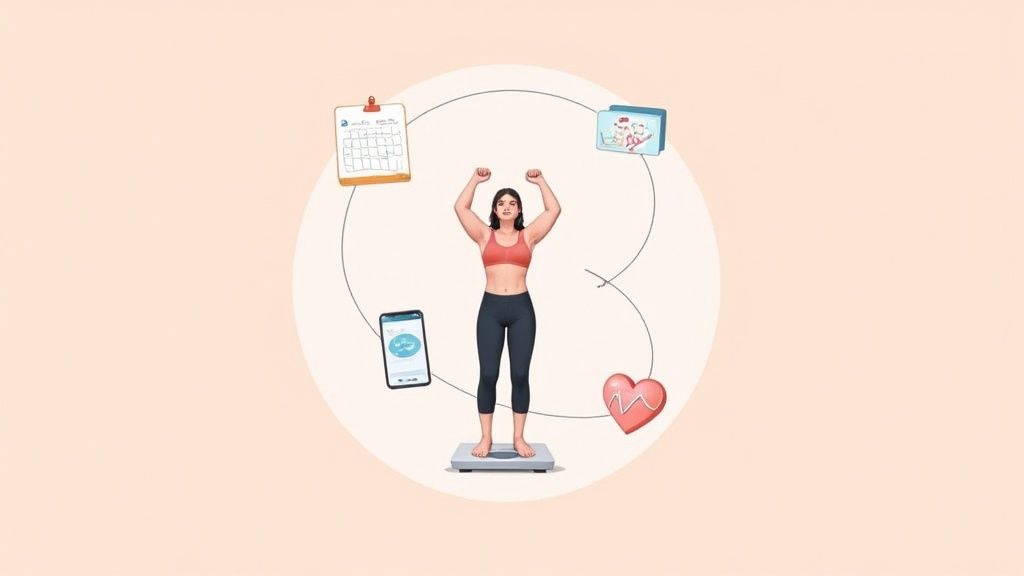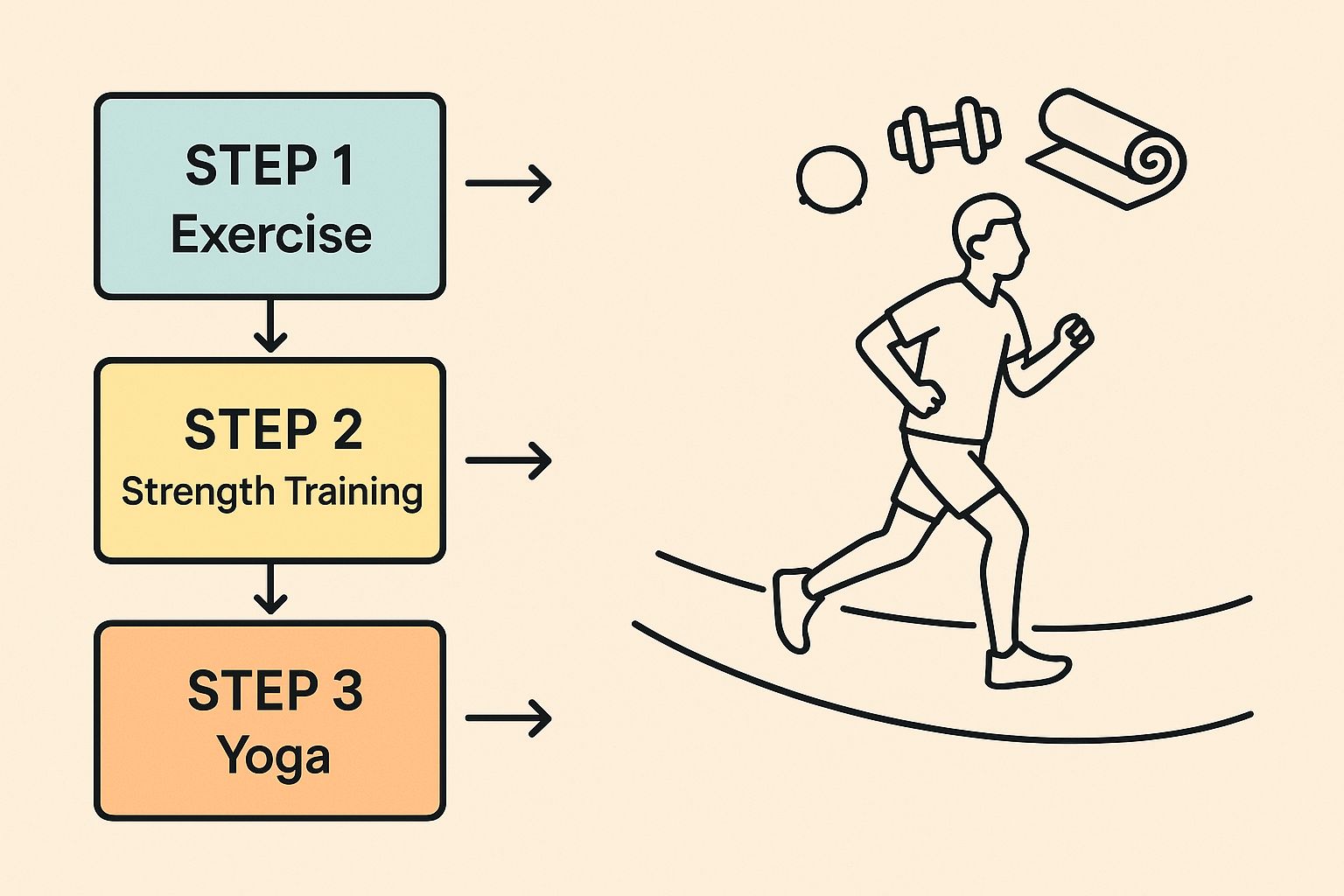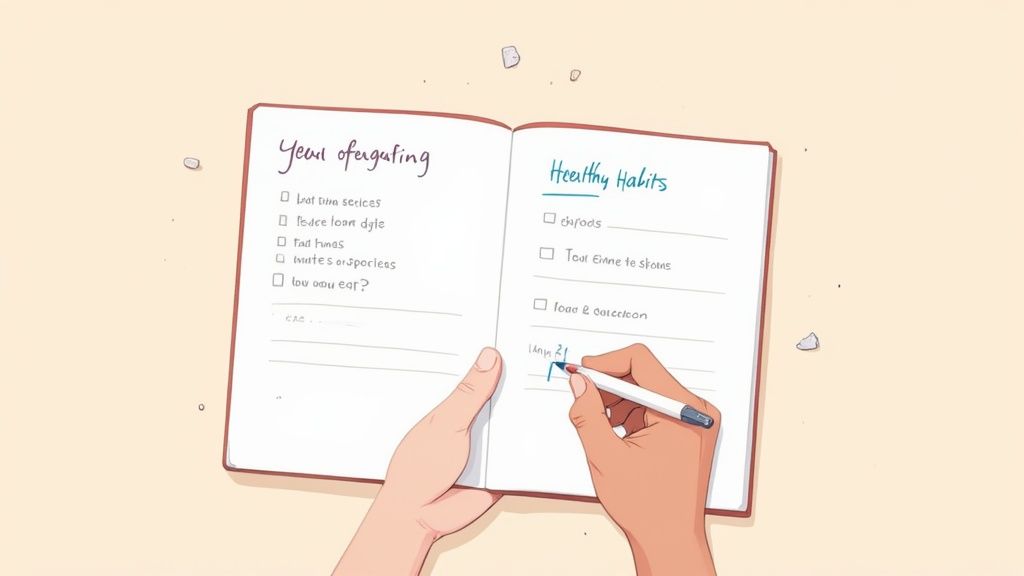How to Maintain Weight Loss for Good

You did it. You hit your goal weight, and that’s a huge win. Seriously, take a moment to celebrate that. But now comes the part that often feels like the real challenge: keeping the weight off for good.
This isn’t about starting another diet. It’s about shifting your mindset from a temporary fix to a permanent lifestyle.
Why Is Keeping Weight Off So Tough?

If you've ever felt like maintaining your weight is even harder than losing it in the first place, you're not alone. And it’s not a lack of willpower—it’s biology. After you lose weight, your body fights back. Your metabolism can slow down a bit, and hunger-regulating hormones like ghrelin often ramp up.
Basically, your body thinks it’s in a famine and tries its best to get back to its previous weight. This is that biological pushback that makes the pounds slowly creep back on, leaving you feeling frustrated and stuck in a discouraging cycle.
A Look at the Numbers
The statistics really put this struggle into perspective. Research shows that while plenty of people successfully lose weight, only about 20% are able to maintain at least a 10% loss for a year or more. It’s a clear sign that maintaining your progress is a marathon, not a sprint.
The key takeaway is this: long-term success isn't about gritting your teeth and relying on willpower. It's about having smart strategies that work with your body, not against it.
That’s exactly what this guide is about. We’re moving past restrictive diets and focusing on building a lifestyle that supports you for the long haul. Understanding the common hurdles is the first step to overcoming them. If you’ve ever hit a wall in your journey, you might also want to read up on what causes weight loss plateaus.
To get started, let's look at the core principles for keeping weight off for good. Think of these as the four pillars holding up your long-term success.
Four Pillars of Sustainable Weight Maintenance
This table breaks down the essential strategies you'll need to master. It’s a quick reference for the foundational habits that make all the difference.
| Pillar | Why It Matters | Simple Action Step |
|---|---|---|
| Habit Formation | Creates automatic behaviors that don't rely on motivation. | Link a new healthy habit to an existing daily routine. |
| Mindful Eating | Helps you recognize hunger cues and prevent overeating. | Put your fork down between bites to slow your pace. |
| Consistent Activity | Boosts metabolism and improves overall health. | Schedule short walks throughout your workday. |
| Emotional Awareness | Prevents stress or boredom from derailing your progress. | Identify one non-food activity that helps you relax. |
Mastering these four areas will give you a solid foundation to build upon, making weight maintenance feel less like a constant battle and more like a natural part of your life.
Building Habits That Actually Stick
Let’s be honest, willpower is overrated. It’s a finite resource, and on a tough day, it’s the first thing to go. Real, lasting change isn’t about white-knuckling your way through cravings; it’s about building smart habits that run on autopilot. This is the secret sauce for maintaining weight loss without a constant internal battle.
A fantastic way to get started is with a technique called habit stacking. Instead of inventing a new routine out of thin air, you simply piggyback a new, desired habit onto an existing one.
For instance, want to get more movement in your day? Try doing ten squats right after you brush your teeth. The old habit (brushing teeth) acts as a trigger for the new one (squats), making it almost effortless to remember and stick with.
This image shows just how those tiny, consistent actions add up to create a healthy lifestyle that feels natural, not forced.

The real takeaway here is that momentum starts with a single, small step. Once that's locked in, it becomes the foundation for adding more healthy routines over time.
Design Your Environment for Success
Another game-changer is tweaking your environment so the healthy choice is the easy choice. If you have a package of cookies on your kitchen counter, you're forcing a willpower decision every single time you walk past. Swap it out for a bowl of fresh fruit and suddenly, the healthy option is right at your fingertips.
This isn't about deprivation. It's about being strategic and removing the little obstacles that stand between you and your goals. These small shifts in your environment compound over time, making it so much easier to follow through on your good intentions.
Remember, the goal is progress, not perfection. Designing your environment means you don't have to rely on being motivated 100% of the time.
The hard truth is that only about 20% of people who lose weight are successful at keeping it off for the long haul. This is often because our bodies fight back, increasing appetite and slowing metabolism. That's why having solid behavioral strategies in your corner is absolutely essential to counter these biological realities.
Start Small to Build Momentum
The thought of a complete life overhaul is enough to make anyone want to curl up on the couch. So don't do it. Instead, start with a habit so ridiculously small it feels silly not to do it. Want to exercise more? Just commit to a five-minute walk every day. That's it.
This approach does two crucial things: it builds your confidence and it creates momentum. Once that five-minute walk is second nature, you can think about extending it.
For a deeper dive into making these kinds of lifestyle adjustments stick, check out these 8 Powerful Behavioral Change Strategies. And if you're looking for a more structured approach, our guide on behavioral intervention strategies can help you build a plan that works for you.
Eating Mindfully to Manage Your Intake
Keeping weight off for good isn't about endless restriction. It’s about tuning in and paying closer attention to what your body is actually telling you. When you shift to a more mindful approach to eating, you start to recognize your natural hunger and fullness cues again—and that's the secret to breaking the cycle of mindless overeating.
Think of it less like a diet and more like a skill you're building. It all starts with just slowing down.
Instead of eating while scrolling through your phone or watching TV, take a few minutes to just sit and focus on your meal. Notice the flavors, the textures, even the smell. It sounds simple, but this one change can make smaller portions feel way more satisfying, helping you realize you’re full much sooner.
Taming Hidden Sugars
One of the biggest obstacles I see people face when trying to maintain their weight is hidden sugar. It lurks in so many foods we think of as "healthy"—things like yogurt, pasta sauce, and even salad dressings. Those sugars can quietly add hundreds of empty calories to your day.
Worse yet, they send your blood sugar on a rollercoaster, leading to energy crashes and powerful cravings that can completely derail your progress.
Your best defense? Become a label detective. Get in the habit of checking the "Added Sugars" line on nutrition labels; you'll be shocked at where you find them. Simple swaps make a huge difference here. For instance, choosing plain Greek yogurt and adding your own fresh berries can slash your sugar intake without you feeling like you're missing out.
A great way to see the connection between sugar and how you feel is to track it. The StopSugar app is designed for this, letting you log sugar-free days right alongside your mood.

When you see the visual proof of how cutting back on sugar improves your mood and energy, it makes sticking with it so much easier.
The goal is to build awareness, not obsession. By understanding what’s in your food, you can make conscious decisions that support your long-term goals without feeling deprived.
Ultimately, mindful eating gives you the power to truly enjoy your food without the guilt. When you listen to your body and know what's in your ingredients, you naturally create a sustainable way of eating that will support your health for years.
Leaning on Tech to Keep the Weight Off
Let's be real—staying on track with weight maintenance can feel like a full-time job. Thankfully, the right technology can act like a helpful personal assistant, keeping you accountable and offering insights you might otherwise miss.
Apps and fitness trackers are so much more than digital food diaries. They help you connect the dots. For instance, you might start tracking your mood and notice that every time you have that sugary coffee in the morning, a major energy crash hits you mid-afternoon. Seeing that pattern in black and white is powerful.
Put Your Data to Work
The magic isn't in just logging your steps or your meals; it’s in using that information to understand your unique patterns. Does your fitness tracker show you barely move on Saturdays? That's your signal to plan a weekend hike or a bike ride to keep your momentum strong.
This takes the guesswork out of the equation. You have clear, personal evidence of what’s working and what isn't. It's no wonder the global market for weight management is projected to reach USD 295.09 billion by 2032, with a huge part of that growth coming from these kinds of tech tools. You can read more about this growing market and its impact and see just how big this trend is.
Think of technology as your supportive partner. It’s there to offer feedback and help you stay mindful, not to add another layer of stress to your day.
Tools like the StopSugar app are built to help you identify the emotional triggers behind your food choices, giving you a much deeper understanding of your own habits. If you're curious about other options, our guide to the best habit tracking apps can help you find the perfect fit for your lifestyle. By using these resources, you can make smarter decisions that support your health for the long haul, making weight maintenance feel a whole lot less overwhelming.
How to Handle Setbacks Without Losing Your Motivation
Let's be real for a moment: weight maintenance isn't a straight line. Life happens. You'll have off days, incredible vacations filled with food you don't normally eat, and stressful weeks where your healthy habits take a backseat. That’s perfectly okay.
The trick isn’t to avoid these moments—it's to learn how to bounce back from them without letting one bad day turn into a bad month.
Viewing a slip-up as a total failure is the quickest way to derail your progress. Instead, I want you to start thinking of it as data. Did a crazy week at work lead you straight to the drive-thru? That’s not a failure; it’s a lesson. It’s your brain telling you, "Hey, next time work gets insane, let's have some healthy, easy meals prepped and ready to go."
This simple mindset shift from "I failed" to "I learned" is everything. It's not about being perfect; it's about being persistent.
Getting Back on Track After a Slip-Up
The secret to handling a setback is to act fast and contain it. If you overdo it one evening, please don't fall into the "I'll start again on Monday" trap. The time to get back on track is your very next meal.
Here are a few simple things you can do immediately:
- Drink a glass of water. Right now. It helps you rehydrate and gives you a small, immediate win.
- Plan your next meal. Make a conscious choice for it to be something nourishing—think lean protein and lots of veggies. This single decision puts you right back in the driver's seat.
- Move a little. Go for a walk, do some stretching, or put on your favorite playlist and dance. This isn’t punishment; it’s a gentle reminder of how good it feels to move your body.
One indulgent meal or even a few off days won't erase months of hard work. It's the prolonged slide back into old patterns that leads to regaining weight. Get back to your routine quickly and forgive yourself instantly.
How to Keep the Fire Lit for the Long Haul
The initial thrill of hitting your goal weight will eventually level out. That's totally normal. To stay motivated for the long run, you need to find new things that excite you.
Try shifting your focus away from the scale and toward what your body can do. Maybe your new goal is to run a 5K without stopping, finally nail that crow pose in yoga, or add 10 pounds to your squat. Performance goals give you a completely different kind of rewarding buzz.
Another great strategy is to celebrate your maintenance wins. Acknowledge every month you successfully stay on track. This simple act of recognition turns the ongoing journey of maintaining your health into something you can be proud of, not just another chore on your to-do list.
Answering Your Biggest Weight Maintenance Questions
Once you've hit your goal, a whole new set of questions can pop up. That’s totally normal—maintenance is a skill in itself. Let's walk through some of the most common things people wonder about as they settle into their new routine.
How Often Should I Step on the Scale?
When it comes to weighing yourself, consistency trumps frequency. Most people who keep the weight off for good hop on the scale either daily or weekly. The idea isn't to get obsessed with the number, but to gather feedback.
Catching a small upward creep early is the real goal here. A pound or two is often just water, but if you see a steady rise over a few days, it’s a gentle nudge to look at your recent habits and make a small tweak. Pick a schedule that empowers you, not one that adds stress.
Do I Really Have to Count Calories for the Rest of My Life?
Nope, not usually. After a while, you’ll likely find you can shift from detailed tracking to a more intuitive way of eating. You’ve put in the work, and now you have a good internal sense of portion sizes and what a balanced plate looks like.
But be mindful of "portion creep"—it's a real thing! That's when your serving sizes slowly, almost unnoticeably, start getting bigger.
A fantastic trick is to do a "maintenance check-in." Just track everything you eat for a few days every month or two. It’s a quick reality check to make sure your mental estimates are still on point and helps you reset if things have gotten a little loose.
What Do I Do If I Start Gaining Weight Back?
First things first: don't panic. A little fluctuation is part of the deal. If you see the scale consistently ticking up by a few pounds, it’s just a sign to get curious, not critical of yourself.
Take a moment to honestly review the last couple of weeks. Have you been less active? Grabbing takeout more often? Are those old late-night snacking habits making a comeback? More often than not, the fix is getting back to the simple, core habits that got you here in the first place.
This is all about a small course correction, not a complete overhaul. The key is to catch it early, address it calmly, and get right back on track. For a deeper dive into this and other topics, you can find additional articles on health and weight management that offer some great insights.